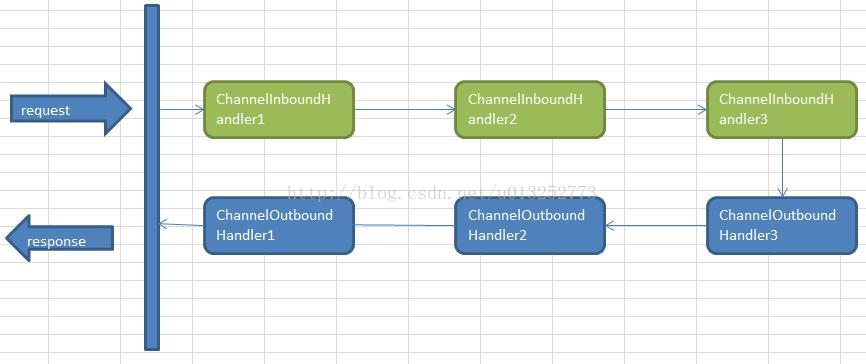1 概述
Netty4.X中的所有handler都实现自ChannelHandler接口。按照输出输出来分为ChannelInboundHandler、ChannelOutboundHandler两大类。
ChannelOutboundHandler:对发送的信息进行处理,一般用来进行编码、发送报文到客户端。如StringEncoder
Netty中可以注册多个handler。ChannelInboundHandler按照注册的先后顺序执行。ChannelOutboundHandler按照注册的先后顺序逆序执行。按照注册的先后顺序对Handler进行排序,request进入Netty后的执行顺序为:
2 实例
该例模拟Client与Server间的通讯。Server端注册2个ChannelInboundHandler、2个ChannelOutboundHandler。当Client连接到Server后,会向Server发送一条消息。Server端通过ChannelInboundHandler 对Client的消息进行读取,通过ChannelOutboundHandler向client发送消息。
Server端共5个类:HelloServer、InboundHandler1、InboundHandler2、OutboundHandler1、OutboundHandler2
import io.netty.bootstrap.ServerBootstrap;
import io.netty.channel.ChannelFuture;
import io.netty.channel.ChannelInitializer;
import io.netty.channel.ChannelOption;
import io.netty.channel.EventLoopGroup;
import io.netty.channel.nio.NioEventLoopGroup;
import io.netty.channel.socket.SocketChannel;
import io.netty.channel.socket.nio.NioServerSocketChannel;
public class HelloServer {
public void start(int port) throws Exception {
EventLoopGroup bossGroup = new NioEventLoopGroup();
EventLoopGroup workerGroup = new NioEventLoopGroup();
try {
ServerBootstrap b = new ServerBootstrap();
b.group(bossGroup, workerGroup).channel(NioServerSocketChannel.class)
.childHandler(new ChannelInitializer<SocketChannel>() {
@Override
public void initChannel(SocketChannel ch) throws Exception {
// 注册两个OutboundHandler,执行顺序为注册顺序的逆序,所以应该是OutboundHandler2 OutboundHandler1
ch.pipeline().addLast(new OutboundHandler1());
ch.pipeline().addLast(new OutboundHandler2());
// 注册两个InboundHandler,执行顺序为注册顺序,所以应该是InboundHandler1 InboundHandler2
ch.pipeline().addLast(new InboundHandler1());
ch.pipeline().addLast(new InboundHandler2());
}
}).option(ChannelOption.SO_BACKLOG, 128)
.childOption(ChannelOption.SO_KEEPALIVE, true);
ChannelFuture f = b.bind(port).sync();
f.channel().closeFuture().sync();
} finally {
workerGroup.shutdownGracefully();
bossGroup.shutdownGracefully();
}
}
public static void main(String[] args) throws Exception {
HelloServer server = new HelloServer();
server.start(8000);
}
}
import io.netty.channel.ChannelHandlerContext;
import io.netty.channel.ChannelInboundHandlerAdapter;
import org.slf4j.Logger;
import org.slf4j.LoggerFactory;
public class InboundHandler1 extends ChannelInboundHandlerAdapter {
private static Logger logger = LoggerFactory.getLogger(InboundHandler1.class);
@Override
public void channelRead(ChannelHandlerContext ctx, Object msg) throws Exception {
logger.info("InboundHandler1.channelRead: ctx :" + ctx);
// 通知执行下一个InboundHandler
ctx.fireChannelRead(msg);
}
@Override
public void channelReadComplete(ChannelHandlerContext ctx) throws Exception {
logger.info("InboundHandler1.channelReadComplete");
ctx.flush();
}
}
import io.netty.buffer.ByteBuf;
import io.netty.channel.ChannelHandlerContext;
import io.netty.channel.ChannelInboundHandlerAdapter;
import org.slf4j.Logger;
import org.slf4j.LoggerFactory;
public class InboundHandler2 extends ChannelInboundHandlerAdapter {
private static Logger logger = LoggerFactory.getLogger(InboundHandler2.class);
@Override
// 读取Client发送的信息,并打印出来
public void channelRead(ChannelHandlerContext ctx, Object msg) throws Exception {
logger.info("InboundHandler2.channelRead: ctx :" + ctx);
ByteBuf result = (ByteBuf) msg;
byte[] result1 = new byte[result.readableBytes()];
result.readBytes(result1);
String resultStr = new String(result1);
System.out.println("Client said:" + resultStr);
result.release();
ctx.write(msg);
}
@Override
public void channelReadComplete(ChannelHandlerContext ctx) throws Exception {
logger.info("InboundHandler2.channelReadComplete");
ctx.flush();
}
}
import io.netty.buffer.ByteBuf;
import io.netty.channel.ChannelHandlerContext;
import io.netty.channel.ChannelOutboundHandlerAdapter;
import io.netty.channel.ChannelPromise;
import org.slf4j.Logger;
import org.slf4j.LoggerFactory;
public class OutboundHandler1 extends ChannelOutboundHandlerAdapter {
private static Logger logger = LoggerFactory.getLogger(OutboundHandler1.class);
@Override
// 向client发送消息
public void write(ChannelHandlerContext ctx, Object msg, ChannelPromise promise) throws Exception {
logger.info("OutboundHandler1.write");
String response = "I am ok!";
ByteBuf encoded = ctx.alloc().buffer(4 * response.length());
encoded.writeBytes(response.getBytes());
ctx.write(encoded);
ctx.flush();
}
}
import io.netty.channel.ChannelHandlerContext;
import io.netty.channel.ChannelOutboundHandlerAdapter;
import io.netty.channel.ChannelPromise;
import org.slf4j.Logger;
import org.slf4j.LoggerFactory;
public class OutboundHandler2 extends ChannelOutboundHandlerAdapter {
private static Logger logger = LoggerFactory.getLogger(OutboundHandler2.class);
@Override
public void write(ChannelHandlerContext ctx, Object msg, ChannelPromise promise) throws Exception {
logger.info("OutboundHandler2.write");
// 执行下一个OutboundHandler
super.write(ctx, msg, promise);
}
}
import io.netty.bootstrap.Bootstrap;
import io.netty.channel.ChannelFuture;
import io.netty.channel.ChannelInitializer;
import io.netty.channel.ChannelOption;
import io.netty.channel.EventLoopGroup;
import io.netty.channel.nio.NioEventLoopGroup;
import io.netty.channel.socket.SocketChannel;
import io.netty.channel.socket.nio.NioSocketChannel;
public class HelloClient {
public void connect(String host, int port) throws Exception {
EventLoopGroup workerGroup = new NioEventLoopGroup();
try {
Bootstrap b = new Bootstrap();
b.group(workerGroup);
b.channel(NioSocketChannel.class);
b.option(ChannelOption.SO_KEEPALIVE, true);
b.handler(new ChannelInitializer<SocketChannel>() {
@Override
public void initChannel(SocketChannel ch) throws Exception {
ch.pipeline().addLast(new HelloClientIntHandler());
}
});
// Start the client.
ChannelFuture f = b.connect(host, port).sync();
f.channel().closeFuture().sync();
} finally {
workerGroup.shutdownGracefully();
}
}
public static void main(String[] args) throws Exception {
HelloClient client = new HelloClient();
client.connect("127.0.0.1", 8000);
}
}
import io.netty.buffer.ByteBuf;
import io.netty.channel.ChannelHandlerContext;
import io.netty.channel.ChannelInboundHandlerAdapter;
import org.slf4j.Logger;
import org.slf4j.LoggerFactory;
public class HelloClientHandler extends ChannelInboundHandlerAdapter {
private static Logger logger = LoggerFactory.getLogger(HelloClientIntHandler.class);
@Override
// 读取服务端的信息
public void channelRead(ChannelHandlerContext ctx, Object msg) throws Exception {
logger.info("HelloClientIntHandler.channelRead");
ByteBuf result = (ByteBuf) msg;
byte[] result1 = new byte[result.readableBytes()];
result.readBytes(result1);
result.release();
ctx.close();
System.out.println("Server said:" + new String(result1));
}
@Override
// 当连接建立的时候向服务端发送消息 ,channelActive 事件当连接建立的时候会触发
public void channelActive(ChannelHandlerContext ctx) throws Exception {
logger.info("HelloClientIntHandler.channelActive");
String msg = "Are you ok?";
ByteBuf encoded = ctx.alloc().buffer(4 * msg.length());
encoded.writeBytes(msg.getBytes());
ctx.write(encoded);
ctx.flush();
}
}inboundHandler2
Client said:are you ok?
outboundHandler2
outboundHandler1
3 总结
[1] ChannelInboundHandler间的传递通过调用 ctx.fireChannelRead(msg) 实现,调用ctx.write(msg)将传递到ChannelOutboundHandler。
[2] ctx.write()方法执行后,需要调用flush()方法才能令它立即执行。
[3] ChannelOutboundHandler在注册时,需要放在最后一个ChannelInboundHandler之前,否则将无法传递到ChannelOutboundHandler。
原贴地址:http://blog.csdn.net/u012635819/article/details/50828339

